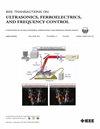52-GHz Surface Acoustic Wave Resonators in Thin-Film Lithium Niobate on Silicon Carbide
IF 3.7
2区 工程技术
Q1 ACOUSTICS
IEEE transactions on ultrasonics, ferroelectrics, and frequency control
Pub Date : 2024-12-30
DOI:10.1109/TUFFC.2024.3522042
引用次数: 0
Abstract
This article reports a surface acoustic wave (SAW) resonator at 52 GHz with a high quality factor (Q) of 188 and a high phase velocity of 12.2 km/s, marking the first millimeter-wave (mmWave) SAW devices with high Q. Transferred 300-nm 128Y lithium niobate (LN) thin film on 4H silicon carbide (SiC) substrate is used for the acoustic platform. The dramatic frequency scaling is enabled by the high phase velocity thickness-shear mode, confined in the LN-SiC stack, due to the high stiffness and acoustic velocity of SiC. The high phase velocity of 12.2 km/s is approaching the longitudinal wave velocity of 12.5 km/s in 4H SiC. The resonator achieves electromechanical coupling (碳化硅上铌酸锂薄膜的52 ghz表面声波谐振器
本文报道了一种52 GHz表面声波(SAW)谐振器,其高品质因数(Q)为188,高相速度为12.2 km/s,标志着第一个具有高Q的毫米波(mmWave) SAW器件在4H碳化硅(SiC)衬底上转移300 nm的128Y铌酸锂(LN)薄膜用于声学平台。由于SiC的高刚度和高声速,高相速度厚度-剪切模式被限制在LN-SiC堆叠中,从而实现了显著的频率缩放。在4H碳化硅中,高相速度为12.2 km/s,接近12.5 km/s的纵波速度。该谐振器机电耦合(${k}^{{2}}$)为0.5%,3db串联谐振Q (${Q}_{s}$)为12,3db并联谐振Q (${Q}_{p}$)为188,最大波德Q为154。经过进一步发展,毫米波固体声学平台可以在信号处理、光力学和量子应用中实现各种应用
本文章由计算机程序翻译,如有差异,请以英文原文为准。
求助全文
约1分钟内获得全文
求助全文
来源期刊
CiteScore
7.70
自引率
16.70%
发文量
583
审稿时长
4.5 months
期刊介绍:
IEEE Transactions on Ultrasonics, Ferroelectrics and Frequency Control includes the theory, technology, materials, and applications relating to: (1) the generation, transmission, and detection of ultrasonic waves and related phenomena; (2) medical ultrasound, including hyperthermia, bioeffects, tissue characterization and imaging; (3) ferroelectric, piezoelectric, and piezomagnetic materials, including crystals, polycrystalline solids, films, polymers, and composites; (4) frequency control, timing and time distribution, including crystal oscillators and other means of classical frequency control, and atomic, molecular and laser frequency control standards. Areas of interest range from fundamental studies to the design and/or applications of devices and systems.

 求助内容:
求助内容: 应助结果提醒方式:
应助结果提醒方式:


